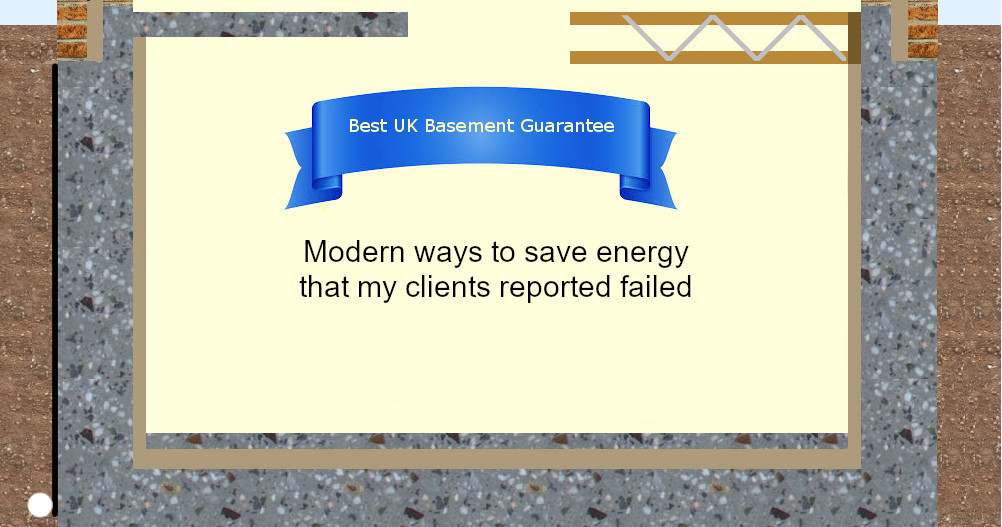| |
House Heating and Cooling Failures.
This page is about the bad ideas that failed my clients.
The good ideas are discussed on a different page.
The tests, whether a technology works for you are, does it work well on the worst days a year? Is it affordable? Is there a 'green' improvement?
The worst failures were heat pumps, with poor workmanship coming in second, ICF third, and thermal mass fourth.
I would like you, please, to understand what your demand for gas is each month with a traditional gas boiler. How much more gas does your boiler use in January and February compared to December and compared to the rest of the year? Your supplier may have this information in your online account.
Heat pumps.
I go into a lot more detail and provide scientific evidence lower down.
|
|
|
Air Source.
300 days a year, an air source heat pump (ashp) easily gets the small amount of heat you need to get 21o inside from air outside that's 16o. It might have an efficiency of four. 300 days a year. Doing very little.
But when it is below freezing outside, the evidence is that your ashp needs more energy from the grid than the energy it is able bring inside. Negative efficiency. Made worse because when electricity demand is very high that extra electricity is generated from gas, which is only 50% efficient - and electricity costs you three times as much as gas.
-
300 warm days a year, your ashp is extremely efficient and uses renewable energy from the grid. But your demand is tiny.
-
35 days a year, your ashp is less efficient because the air outside is cooler, and you are using more electricity from the grid to remain warm.
-
For about 30 days a year the air outside is very cold, and all the air source heat pumps in the country are on at once. They struggle to bring in heat, using more watts of electricity than the watts of heat they recover. And this extra electricity is generated from gas, which is only 50% efficient. Twice the CO2 emissions of a gas boiler.
-
300 days a year you save an insignificant amount of money and carbon emissions on a small amount of heat.
-
35 days a year you break even, compared to a gas boiler.
-
30 days a year, you use a hundred times the energy to find 10 times the heat, all at 3 times the cost. Most of your annual heat bill.
Statistically, it is argued, your ashp is more efficient most days of the year. But the financial cost and the environmental cost of air source heat pumps over each whole year is greater than a gas boiler.
From time to time I am going to quote a customer who began their basement in 2021 and by 2025 had experienced at least 2 winters in their new home. Note that some suppliers' advice was far from good. Presumably based upon profit. This is from her father.
I will always use brown, because above ground they have a very insulated timber frame.
"the heat pump works well and the house is kept quite warm 24/7."
"I would say they received bad advice for the air system MVHR as the whole 7 bed house is treated as one box. It pulls warm damp air from bathrooms, kitchen and laundry and returns air throughout the house. Hence every room upstairs, downstairs, used or not, is the same temperature."
"I think they spend up to £800 a month in the coldest months on electricity. It's a fully electric house. No gas." Later, he mentioned £8,000 per year.
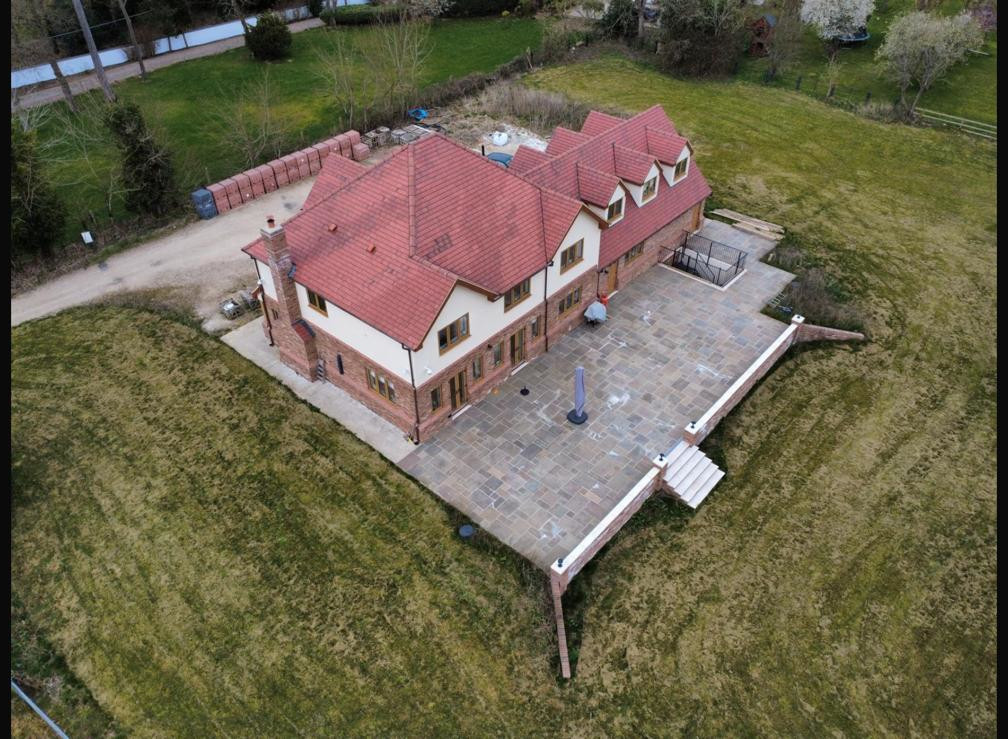
That may not be a very unusual amount for an older detached home. But this new. Insulated, air tight, and with heat recovery. Why so expensive to run?
The reason for 7 bedrooms, is that part of the far area (over their basement) can be isolated for granny and grandad.
They are looking into solar panels and batteries to reduce their dependence on grid electricity. Perhaps they should look at electric cars for their battery storage and a ZEB for heat storage.
Ground Source.
A Ground Source Heat Pump (gshp) is different because it cools the ground you get heat from. The problem is that the ground, deeper than a couple of feet, isn't warmed again by the sun in summer. The ground, according to scientists, is "thermally inert". It does not conduct heat.
Year One gshp works brilliantly.
Year Two gshp are disappointing.
Year Three gshp cost a king's ransom, and get turned off before spring.
There isn't a year four. The ground around your pipes is frozen solid. Your gshp is turned off. In desperation, you bought electric fan heaters from Argos or Screwfix.
Year 20 to 30. The ground eventually thaws out - and collapses. You now have a huge hole in your lawn.
The growing problem with more and more people getting a heat pump, is that on the coldest day each year they will all be demanding more electricity from the grid than the grid can carry. The grid will fail. Power cuts for everyone. Then what?
I keep my eyes peeled for independent evidence from others.
At the Futurebuild Show 2024 there was huge concern. Speakers were warning the grid won't cope.
Less than a week after I was at the 2024 Futurebuild exhibition, the then Prime Minister, Rishi Sunak, said we need to build more gas fired power stations.
news article here.
My guess would be that he understood that more heat pumps require more electricity, and the national grid needs more generation. But he didn't want to admit the incentive scheme for more heat pumps was wrong. Therefore, keep the heat pump grant and burn more gas making more electricity than the gas boilers the government, even Kier Starmer, seeks to replace 'to save our planet'.
It is obviously bonkers.
|
The BBC has an article (August 2023) about heat pumps with mixed thoughts here.
January 2nd 2024 I spotted another update from the BBC here. It says that air source heat pumps are getting a lot better.
And on July 19th 2024 I was emailed by Rightmove and it linked to an article by Octopus Energy's heat pump expert here.
Please read the last two articles with a bit of cynicism. They are based upon what suppliers who want you to give them the £7,500 government grant are selling, in order to make themselves a lot of money. The BBC were told that in cold weather the ashp would be 'effective'. But not that it would be 'efficient'. Octopus Energy would be your electricity supplier as well as your ashp supplier. They want the £7,500 grant money and the extra electricity sales worth up to 10 times the old gas sales.
And. When I re-wrote this page over Christmas 2024, I found this page from another heat pump supplier Viessmann. I quote: "The boilers already in place are tasked with covering peak loads. The rest of the time, the Vitocal heat pumps provide heating and hot water".
The rest of the time we can rely on air-tightness, HRV, ZEB, solar gain, solar panels, wind power, and so on. Heat pumps are of no benefit.
The good ideas are discussed on a different page.
Workmanship.
A statistic from an expert at a workshop 'Whole Life Carbon at the Futurebuild exhibition on March 7th 2019'
He described that in order to get data his team analysed a new home just completed by a mass national housebuilder. The SAP calculation approved by building control was a U Value of 0.16. But the actual U Value, mainly due to poor air tightness and cold bridging, was worse than 0.30.
From the Grenfell Tower Inquiry.
'Shockingly poor workmanship' went 'unchecked'. Rydon's project manager for the Grenfell Tower refurbishment was unable to explain the presence of 'shockingly poor workmanship' of cavity barriers in the cladding system installed on the building at the Grenfell Tower Inquiry.
The point is, experienced labour are extremely good at cutting corners and ruining a good design.
The architects who won the Stirling prize (see the page about what works) for a passivhaus design stressed workmanship and proof the work was carried out well.
The new Building Safety Act 2022 includes within it a requirement that the workforce proves to the architect they did their work properly. (Find out more on my page for architects or on my page about the new requirements).
It might not matter what you choose if the building work and installation are not supervised.
Insulating Concrete Formwork ICF
I built with ICF for about 8 years but there are four major reasons not to use it.
-
It went out of shape and burst. Despite repairs, it means gaps in your insulation. Cold bridges to the outside.
-
Insulation both sides of the concrete is just plain wrong because the inner layer of insulation will be too thin. You will still be trying to heat or cool the concrete.
-
All ICFs have to be filled very gently. Either you use over-wet concrete, which will always be porous and a basement will leak. Or, if you use any waterproof concrete it won't be waterproof because you mustn't vibrate it fully. Therefore, it will leak.
For the same reasons, heat will escape through low density concrete. You may even have draughts.
Tracing leaks and draughts means taking the insulation off one side at least - and throwing it and your money away.
I tell you more about why you should not use ICF on another page here.
Thermal Mass.
Over Christmas 2024 I have changed my mind about thermal mass.
I set up an experiment into thermal mass 4 years ago. The test structure is a bungalow fully glazed on the side facing almost South (actually SSW with a tree at WSW).
The amount of heat gain from a few hours of sun in the winter is amazing - and free.
But a few continuous days without sun means that on winter nights it gets very cold. Bitter. The bare concrete inside does not store enough heat and it gets cold. When I turn the heating on, it is trying to warm up the concrete as well as me.
I don't save on heating during the coldest, darkest days. I spend more than I need to.
Solar gain is good if you just warm the air when you need to.
And using bare concrete to soak up excess heat during the day and releasing it to the outside with ventilation overnight, which is what tall office blocks with thousands of computers do, is probably good.
But using your concrete as a heat store is bad.
With hindsight, my experiment was doomed to fail because in order to have heat come out of my thermal mass at night, it wouldn't do so until the air inside got very cold. And it would only partially keep it warm.
By this time, the room is quite cool and so are the walls and floor. Not what you want because you want to avoid touching the walls. And your heating now has to heat up the walls, as well as the air, to your chosen living temperature - which requires many more times energy.
Heating both concrete and air to feel comfortable is the killer for thermal mass.
For thermal mass to have kept your room warm and comfortable till morning, it needs to be warmed up with the air temperature in the room far higher than what would be comfortable for the people occupying inside. So it won't happen.
|
___________________
___________________
___________________
___________________
___________________
|
More about Heat Pumps, including scientific evidence.
The economics and efficiencies of heat pumps is all about the weather and where the electricity comes from. Not the pumps themselves.
More about thermal mass lower down.
The UK and USA Governments both chose Heat Pumps as the way to reduce their country's carbon emissions. But heat pumps do not make sense.
I have been gathering evidence about heat pumps for several years, since some clients reported that after 3 years their ground source heat pump didn't work any more. Their shallow coils quickly froze their ground and it would not warm up again sufficiently over Summer to give up any heat next Winter.
A little birdy has told me that the £3.1m government grant given to Winchester University to replace gas boilers with heat pumps is going pear-shaped. It isn't producing the heat or the savings in money or carbon dioxide expected.
There is talk of litigation.
This government web page lists and provides links to the massive government funding given out under the Public Sector Decarbonisation Scheme.
I think that a lot will prove to be going wrong.
|
When your heat pump cannot find heat easily, it finds heat using far more electricity. You are warm. But, sadly, that extra, expensive, electricity mostly came from gas fired power stations, only 50% efficient and churning out CO2.
I called an old client from 8 years earlier. He said that his air source heat pump ices up in very cold weather and makes heat to de-ice itself. I presume that it uses mains electricity to de-ice itself, which would mean it is using electricity that brings in zero heat during this process.
During March 2024 I read an academic paper from the 1990s. I learned that when a ground source heat pump freezes the ground around the pipework, that if and when that soil is able to thaw out, the water can separate and rise to the surface causing the soil to settle, they said 22%, damaging and putting the GSHP pipework out of action.
I discuss this paper in detail lower down.
A new client in December 2022 turns out to have worked in the energy industry for many years including a time as the manager of a gas-fired power station.
He was trying to help me understand how the wholesale price of electricity was influenced by many variables and how the variable wholesale price affected the economics of a heat pump.
It really isn't simple. I tried a few times to explain it but he kept saying I got it wrong. Therefore, I have collected his emails together into one pdf document that you can read here.
The point of this little lesson in the economics of generating electricity is to illustrate why every extra 1kWh hour of electricity from gas generation costs about 2kWh of fossil fuel, which that extra electricity will be when many heat pumps are all struggling at the same time.
That means twice the carbon dioxide produced for each kWh of electricity used by a heat pump in cold weather compared to each kWh burned in a gas boiler.
And it means that in cold weather the quoted efficiency of heat pump is halved, compared to a gas boiler. For an efficiency of 4.2, read 2.1 in cold weather.
And with the price of gas a third the price of electricity, that 2.1 becomes 0.7.
And with the ashp using more Watts than it brings in, the 0.7 becomes 0.2 on the coldest few days a year when you want the most heat.
Heat pumps are less efficient and cost more to run, as well as more to buy, and responsible for more CO2 emissions, than a gas boiler over the whole equipment lifetime.
But while there is a £7,500 government grant available, lots of sales people will tell you the opposite.
In the Octopus heat pump article, linked to above, they state: "We sorted fact from fiction with some help from Octopus Energy's resident heat pump expert, Ben Palmer."
Ben Palmer seems to be a training officer. His Linkedin page has lots about training. Almost nothing about heat pumps. Google him yourself.
The article describes poor systems, better systems and best systems. The best system can save £170 a year. But, only if
-
You disconnect your gas (it doesn't say how much this will cost), which saves about £170 a year in standing charges.
-
Your system costs more than the average £14,000 quoted. More than £6,500 after government grant.
-
Note also, the article says that the installer will claim the government grant, not the householder. That's why it is lucrative enough for companies to lie, or at least mislead.
We could never have enough wind turbines of our own, because too many on some days is not enough on others. We couldn't have enough for absolute peak demand because most of the year many would be idle and the investors, the tax payer, will never get their money back. Investors will only pay for a turbine that will be busy and earn a return.
It is better to share with countries far away across Europe, to even out demand with supply and keep most wind turbines working and earning most of the time.
The best time for a wind turbine is in winter and a high pressure weather system. Because that is when we have wind, the highest air pressure, and the coldest temperatures that make the air denser and stronger to turn turbines.
But weather systems come and go. They don't all sit conveniently over Britain.
To make full use of the best turbine weather we need turbines over ten times the area of the UK.
We need to be connected to Europe so that when we have too much we can sell some to them, and when they have too much they will sell some to us.
We will always need gas fired power stations to top up supply when demand is high but sunshine and wind are lacking. Therefore, if we shut all our gas fired power stations and our politicians stood up and exclaimed how green we are, we wouldn't be green at all because we would still buy gas fired electricity from Europe when too many heat pumps were struggling - in cold weather when we want the most heat.
What effect does cold air outside have on an Air Source Heat Pump?
We can learn a lot from a lengthy study into Ground Source Heat Pumps where the heat is obtained from boreholes. I provide a full reference and more information lower down. For now, let us study figure 3.

Within only 3 or 4 days the heat extracted from the boreholes dropped significantly. The heat obtained for the same amount of electricity was already less. The Coefficient of Performance (CoP) had dropped significantly. After 60 days the drop was as much again and after 120 days the temperature of the refrigerant coming out had dropped about 40% from the start before any heat had been extracted.
For the same amount of grid electricity to power the system, the CoP dropped 40% over a season.
Clearly then, an air source heat pump CoP would also drop as the air temperature dropped outside throughout Autumn then Winter.
Link to the academic paper, mentioned above, about the longer term effects of Ground Source Heat Pumps.
This is the source page
and this is the .pdf I downloaded from it.
These tables are also copied and pasted from the .pdf.
very clear deterioration over 15 years.


Between a and c you see the recovery of heat after heat extraction for one year.
between b and d you see that after 15 years the soil clearly starts each cold season colder than previously, and comparing b to a, after 15 years heat extraction is clearly less efficient.

|
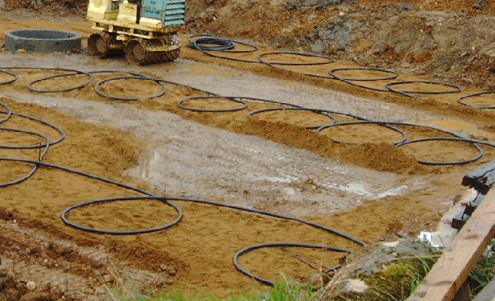
|
|
A client burying shallow GSHP pipes 2m deep.
|
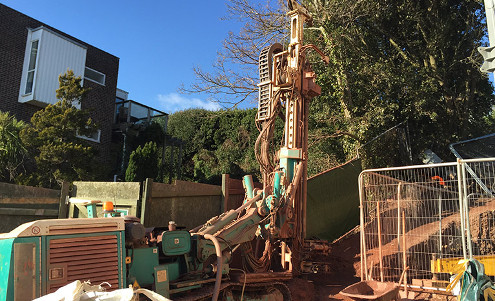
|
|
A GSHP borehole being drilled.
|
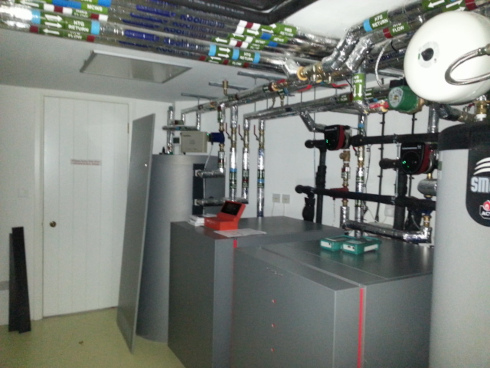
|
|
A client's heat pump installation in Buckinghamshire.
I kid you not. He said he went over his £50,000 budget.
|

|
|
A client's GSHP and, on the right, water heating comprising a hot water tank with an air source heat pump on top.
Instead of his ASHP bringing heat in from the air outside, this client has Mechanical Heat Recovery Ventilation and after the air on its way outside has given some heat up to the air coming in, that air, which is still warmer than the air outside, gives up more heat to the ASHP and that heat heats their domestic hot water.
They seemed to think it worked.
|
This article about living with a heat pump was published by Homebuilding and Renovating June 2022.
I have copied and pasted it because it might disappear from their web site. I have omitted the images and adverts.
He does not tell us that his heat pump remained efficient on the coldest days. Yet he must know that is a big concern for many.
But, very usefully, he does explain the scope of the necessary works.
What is it Really Like to Live With a Heat Pump?
Energy expert David Hilton installed an air source heat pump three years ago, a decision which gives him confidence the technology could suit most UK homes
Heat pumps have been heralded as the future of home heating, but while there are a lot of people telling us how great heat pumps are, not as many people are telling homeowners what it's actually like to live with one.
Air source heat pumps and ground source heat pumps come with a variety of pros and cons, much as gas boilers do, and choosing to opt for a heat pump is a bold decision. It can require quite significant research and preparation, but specified in the right way, they have potential to make your home cheaper and more carbon-friendly to run in the long term.
I installed a heat pump three years ago, and from the initial decision-making process to installation to adapting to the way your home is heated, this is what it's like to live with one.
We had been living in our home for nine years with an oil fired central heating system.
We are not rural, but at the time when our home was built in the 1980s our little development was equipped with electrical storage heaters. Over the years many of these homes were subsequently fitted with a wet central heating system and oil or LPG gas boilers. Ours was one such property.
When, as a family, we started to outgrow the property we went through the motions of evaluating whether it would be better to move to a bigger property or extend the existing one. Building an extension won, and as the project moved through the design stage we realised very quickly that the oil boiler would simply not be good enough for our newly enlarged home.
The other issue was that the boiler flue protruded through a wall where the new lounge would be, and the new lounge would block the route to the oil tank for refilling. If we were to keep an oil boiler then the boiler position and the tank position would need to move. These were both not easy options so what was the alternative? Yes, an air source heat pump.
Getting Our Home Ready For a Heat Pump
An air source heat pump moves heat from the air outside to your home. The water flow temperatures in the central heating circuit are a lot lower than you have with a boiler, therefore the emitters often need to be increased or you need to have underfloor heating installed.
To make an air source heat pump run efficiently you need to optimise the efficiency of the home as well, so the design stage of the project received a new injection of detail.
We looked at ways to improve our insulation and make the property more draught proof. The central heating system was inspected to make sure that the radiators were big enough for much lower flow temperatures, and that the pipework was big enough to carry enough heat.
If you have a microbore pipe (10mm - 12mm, it does not matter if it is copper or plastic) then a heat pump system can really struggle to deliver the heat. Oversized circulation pumps can be used to overcome the resistance but then there could be additional noise in the pipes, unbalanced emitters and lower efficiency due to pump power consumption.
How We Chose Our Air Source Heat Pump
The emitters were all acceptable and a heat loss calculation was done to determine the size of heat pump required. It came back at around 8kW so we selected a heat pump of around 11kW to cover the heat load when it is very cold outside.
The choice of heat pumps available is increasing every day, and there are a number of things that differentiate between different air source heat pump products.
First you have the choice of monobloc or split. A monobloc has the refrigeration plant in the box outside the property and the unit is connected back to the home via water pipes and electrical wiring. There is no refrigerant pipe. A split system has half the heat pump outside and half inside the home, with the two bits connected via a refrigerant pipe.
Monobloc units are the most common air source heat pumps in England, and that is what we chose.
Two issues I was slightly concerned about was that the outdoor fan unit may be a bit noisy in our garden, or that it had been designed to only supply heat to the central heating. As it was, the hot water is provided by a second heat pump built into the hot water cylinder, and receives air from the exhaust of the heat recovery ventilation systems. It might sound complicated but in real terms it's not: the set-up essentially comprises two different heat pumps with different refrigerant gas that behave in different ways.
The outdoor unit could potentially supply the hot water as well but we did not want it to run in summer, and we wanted to use the waste heat in the stale air in the ventilation system.
We did not want to have the outdoor heat pump run in summer because even though we have close neighbours, and it passed the noise test for planning permission, we were still sensitive that it might disturb them when all the windows are open in the summer. As it happened this unit is really quiet and we need not have worried.
How Easy Was Installation?
The ductwork for the hot water heat pump was the most tricky thing to install, but the rest of the installation went very smoothly. A solid base was built for the outside unit and the pipework was installed as new parts of the extension were completed. We then changed all the Thermostatic Radiator Valves for wireless motorised valves to provide accurate room-by-room thermostatic control.
How Has My Home Heating Changed?
We’ve had the heat pump for three years now, and there are a number of things that we have had to get used to. The radiators no longer become radiant hot, for example. You can hold them and you won't get burned.
The flow temperature was initially set at 48°C and dropped a few degrees in mild weather. As we got used to the system we lowered the flow temperature to 38°C and it drops to around 28°C in milder weather. You do have to get used to the fact that the heat has a much slower reaction time. As the reaction time is slower, more careful room control is required.
The different zones (rooms) are set on a schedule to not all come on at once, and we stagger the times when the rooms call for heat, thus reducing the load on the heat pump. The heat is gentle. Whether it is the rooms with underfloor heating or radiators they are all sized to run at the same temperature so they all operate on the same circuit.
As the reaction time is slower, more careful room control is required. The stored water temperature in the hot water cylinder is lower than it would be with a boiler - you would expect the water to be around 60°C to 70<°C with a boiler, but a heat pump does not like to make that type of heat and many cannot get to that level without the use of a back-up electrical heater.
The temperature of a shower is around 38°C so it doesn't really matter that the water is stored at a lower temperature of around 50°C because you can use a bit more water from the cylinder and mix in less cold. This does mean, however, that you will have a slightly larger cylinder than if you had a boiler. Our cylinder is 300L rather than a 250L boiler option, but considering that Building Regulations now require your water to be no more than 48°C at the tap, the lower store temperature will make no difference.
Has the Heat Pump Been Cheaper to Run?
Initially the air source heat pump was more expensive to run than the oil boiler, but when you factor in that oil was really cheap several years ago, and we had not really got to grips with the nuances of living with a heat pump, the pendulum soon swung the other way.
Oil was 34p per litre when we put in the heat pump. You get 10 kWh per litre so that is around 4p per kWh when you factor in the boiler efficiency.
Electricity was 12p per kWh and the heat pump was only 250% efficient (when measured in the house not at the heat pump) meaning that it cost around 5p per kWh.
Now electricity is 28p per kWh so each unit of heat costs 11p but oil is now around £1 per litre so when you factor in the efficiency the cost is about the same. But, we have solar PV panels so quite a lot of the electricity, especially in the summer, is free.
What Else Did I Notice?
The heat pump has never been a noise nuisance and the temperature in the home has always been comfortable, even when there was a load of snow outside. It is, however, imperative to get the heat pump designed and installed by experienced installers who understand your home, your expectations and most of all the working habits of the heat pump.
In the three years since installing the heat pump the technology has moved on, and the new refrigerant gasses and better software - as well as our experience of having a heat pump solution in a 1980s renovated property - fill me with confidence that air source heat pumps can indeed be a successful long-term solution for most UK homes.
David Hilton
David is a renewables and ventilation installer, with over 35 years experience, and is a long-standing contributor to Homebuilding and Renovating magazine. He is a member of the Gas Safe Register, has a Masters degree in Sustainable Architecture, and is an authority in sustainable building and energy efficiency, with extensive knowledge in building fabrics, heat recovery ventilation, renewables, and also conventional heating systems. He is also a speaker at the Homebuilding & Renovating Show.
Passionate about healthy, efficient homes, he is director of Heat and Energy Ltd. He works with architects, builders, self builders and renovators, and designs and project manages the installation of ventilation and heating systems to achieve the most energy efficient and cost effective outcome for every home.
|
A few clients, over the years, mentioned storing summer heat in a water tank in their basement to partly heat cold water in winter before that water reached their boiler. But it always seemed a problem insulating that tank well enough for it to really work well.
Modern Methods of Construction MMC.
There is a lot of talk about improving the quality of house building by building homes in factories and delivering them in panel form and erecting them on site. I imagine that to be true and beneficial.
But, during 2022 and again during 2024 these factories seem to have been closing faster than they were opening.
In March 2024, Barnet Council warned government that a combination of timber frame and uPVC cladding combined to spread fire through 4 terraced houses, destroying all four.
More information and some maths behind Wind Turbines.
In this short video, a BBC correspondent explains quite clearly why domestic wind turbines are sadly a waste of money.
A wind turbine with a radius of 1m captures energy from wind over about 3m².
A wind turbine with a radius of 2m captures energy from wind over about 11m².
A wind turbine with a radius of 25m captures energy from wind over about 1570m².
A wind turbine with a radius of 50m captures energy from wind over about 6300m².
You would need more than 2,100 1m radius wind turbines on houses to match the electricity generated by one large turbine in the North Sea.
20 times higher mast 572 times as much electricity.
This is why wind turbines are in the North Sea and on hillsides, not on every house. They are a waste of time on a house.
Going Green and having the opposite effect.
The experts at the Futurebuild workshop discussed the high carbon cost of materials and equipment as well as energy. Apparently, specifying up to 8 times the equipment needed is not uncommon. Neither is it uncommon to completely replace a whole unit instead of replacing just the part that failed. This all wastes carbon emissions and precious water along the supply chain.
They went on to explain that sourcing all the building materials and all the materials your equipment is made from, as well as all the transportation; and the end of life costs in removing and replacing anything all add up toward your Whole Life Carbon. A concrete office block completely gutted and refitted when a new tenant moves in and then demolished after only 10 years to be replaced by an even bigger concrete tower, is a terrible waste of carbon.
One of the expert's teams had to quantify the carbon in a new public building. They found that a lot of the timber was Canadian but it had been sold and moved to Southern USA before being purchased and transported to Britain. The total carbon was more than twice Scottish timber that only travelled 300 miles or so.
The environmental cost of new equipment.
Iron is melted to extract the rust from ore.
Iron is melted again to extract the oxygen from rust.
Iron is melted again to produce steel.
It is very easy, when extolling the virtues of alternative energy, to forget that the iron used to make the kit was mined in Australia and it took a huge amount of coal and water to firstly remove the rust from the rock, second to purify the rust into iron and third to turn iron into steel. It required oil to power the transport around the world. The same for the copper pipes, the plastics, the aluminium and the copper wiring. We use a huge amount of energy and water to turn earth resources into manufactured products. Buying kit used a lot of water, created pollution and increased global warming. Changing a component or throwing the whole thing away and replacing it creates even more.
In comparison, how far would your concrete travel? The aggregate, 77% by weight, might be quarried where they batch the concrete. If so usually a maximum of only 20 miles. The cement: a 15th of your concrete might have come from Port Talbot and another 15th from Greece. Another 15th is the water that only travelled as far as the truck. Overall, concrete is greener than many suppose.
Some of the best results the experts at the workshop got anywhere were concrete used where its useful life would be expected to exceed 150 years - which could be your new house and basement. The carbon investment in a concrete house becomes insignificant annually if it will be in use unchanged for 150 years.
Another cause of carbon waste the experts were keen to make clear was the effect on Whole Life Carbon designing a building and its services to fully meet the demands for energy during the coldest and the hottest times.
The experts said that in order for every building in the land to get enough mains energy for air conditioning during the hottest few hours a year and full-bore heating during the coldest few hours a year, the extra national grid infrastructure and extra building equipment and services and energy certain to cope are twice what is required on the other 363 days a year.
They impressed upon us that if our buildings can only cope with 95% the peak demand during the coldest and hottest few hours a year, then the total Whole Life Carbon for everything required (mains supply infrastructure, equipment and energy) is halved.
And the way to smooth out the need for peak energy is thermal mass.
One of the experts said that his Victorian, London home, refurbished to maximise thermal mass, air tightness, insulation outside and heat recovery ventilation maxed at 25oC throughout the heat wave last year. A new build could do even better.
I find it very interesting that my own study found thermal mass to be probably good at cooling and avoiding air conditioning. But bad at storing enough solar gain in winter to prevent the occupiers feeling cold when the concrete got cold. And the expert's findings don't disagree - but they fail to point out any benefits or drawbacks in winter, which are omitted.
Some years ago, I Googled MHRV and looked at Images. This was first page. Your MHRV supplier might well try to supply you with an average one air change per hour with ducting to every room. But will this be too much when everyone is out or asleep?
And will he tell you to put your equipment out of reach?
An exhibitor at the HB&R Show I spoke to was angry that MHRV would not work after the first couple of years because filters weren't being changed.
Filters must be accessible to hoover out lint and change when necessary. More about this on the page about what works.
|
|
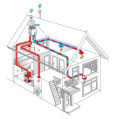
|
Underground Thermal Energy Storage. UTES.
Put heat into the ground over the summer. Extract that heat over the winter.
Here is the bad news. What failed. On the page about what works I have a few words about what might work better.
Soil has high thermal inertia. Heat travels through soil slowly. When you put heat in, months later it hasn't travelled far by conduction. You could keep your heat to extract when you want it.
Whether you can just flow water through the heated soil to heat the soil up, or whether you need a heat pump to extract your heat, I don't yet know.
However, you extract heat with a heat pump a lot more easily from your UTES at an elevated temperature, compared to struggling to extract heat from a source below freezing.
This is a suggestion from an academic paper here. I already linked to it and a .pdf I downloaded higher up this page.


|
|
This heat store has no hard boundary. They augered holes with a piling rig on 1m centres and inserted their heat source and heat recovery lines before backfilling their holes.
The purpose of this academic paper was to identify difficulties with the process, rather than proving the benefits of the process.
They want others to design solutions to the problems they identified before they commence their own UTES.
Some of the problems they found were
1. The insulation over the top and partially down the sides lost some efficiency over a few years which they blamed upon vapour from the heated soil penetrating the insulation.
2. They lost a pipe because it got damaged when they augered in between pipes to install their monitoring sensors.
3. One of their heat recovery pipes was lost because it got squashed as soil settled within their heat store.
Settlement turns out to be a large and varied problem. It is worth reading the paper for yourself if you get this far with your own design.
1. As water is driven off by vapour it leaves a space and the soil can settle.
2. The backfill is unlikely to be consolidated, and, over time, it can settle further as well as surrounding soil can leach into the backfill voids. This amounted to about 80mm over 3 years.
3. THE BIG ONE.
|
3. THE BIG ONE. FREEZING.
They found that when the ground source heat pump they used froze previously-never-before-frozen soil, water separated from the soil volume. When that soil thawed it caused substantial collapse of the soil and the water rising to the top.
22%. More than 2m drop with pipework 10m deep.
It was this freezing, thawing and settlement that put one of their ground source heat pump pipes out of action
and, clearly, maintenance and repair of pipes down deep and backfilled columns is pretty difficult. They left it broken and out of action.
It made them include a warning not to sink your ground source heat pump pipework deeper than or close to foundations.
Nor to position your UTES on a slope.
You would not want your home subsiding nor your plot slipping down a hill.
Their purpose was looking for problems.
They heated their store with electricity to 70°C before extracting heat.
You might be able to heat your soil to 70°C with solar heated water from your roof panels. But not a lot higher with water, because if the water in your system boils I expect you will get a raft of other problems.
Whereas, with electricity from photo voltaic panels on your roof, you could heat the soil to hotter than 70°C (though, I suspect, not to 800°C)
It seems essential that no part of your UTES should ever be allowed to freeze. Let alone made to freeze by GSHP.
|
This technology first caught my attention in 2018. Seasonal Thermal Energy Storage. STES.
Icax Promotes pumping heat into the ground beside GSHP coils.
There is an academic exploring a similar idea. A chartered engineer and chartered geologist, she is a research fellow whose blog describes her excitement at the idea. Two of her blog pages here:
testing and monitoring. STOP PRESS. 2024 she is a professor.
|
I do not have any figures for the storage capacity of different soil types or contacts with the adapted piling rigs in the images above.
I do not know whether your UTES could be hot enough to extract heat all winter just with a flow of water, instead of GSHP.
I do not know how a piling rig on tracks is supposed to drill the hole for the pipes and not inadvertently partially fill the hole by accident, or chew up the new cables and pipes, when it tracks around to auger the next hole.
Come back to this page from time to time, because I am going to try to interest academics into looking into this further and giving me more knowledge to add.
If you want to save energy and reduce CO2, you must avoid filling your home with clever kit that requires immense amounts of energy and water to produce the steel and copper but doesn't save anything on the hottest or coldest days each year, you must make sure your architect finds a sensible place for your MHRV unit and of course you need to insulate, reduce draughts and avoid over heating in summer.
And work probably needs to be supervised if you don't have the work carried out by the most reliable person you know - yourself.
I am convinced that once built and lived in, a new home with a basement could be much greener than a standard structure today. Maximise its use of virtually free electricity from the grid and storing it, partly at least in a ZEB. Solar panels to charge your electric car. Solar gain with air tightness, insulation and MHRV, would require the least energy to make the kit and to keep the dwelling warm and cool compared to any other scheme. Read about it here What worked for my clients.
You might not like any of my thinking. Fair enough. I'm not selling it. I'm only sharing it.
Phil Sacre
2018, 2019, 2020, 2021, 2022, 2023, 2024, and 2025.
Back to the Basement Building Questions Answered menu.

|
Forward to the Basement Building Construction Manual menu.

|
For a fixed fee of £199 I will answer all your questions by email. More details here.

|
Previous Page
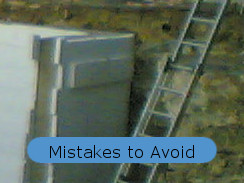
|
|
Next Page

|
|
The Page After That

|
|
|
|
